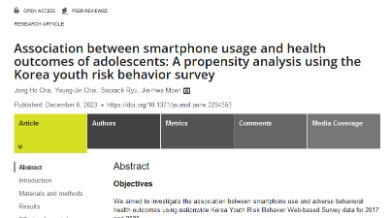Over 4 hours of smartphone use leads to serious health risks for teens
SEOUL, South Korea — Teenagers who use smartphones for over four hours a day are at a “serious” risk for certain health issues, a new study warns. Researchers say that increased smartphone use has been linked to psychiatric disorders, sleep disturbances, eye problems, and musculoskeletal issues.
The study found that adolescents with more than four hours of daily smartphone use exhibited higher rates of stress, suicidal thoughts, and substance use compared to those with less usage. They also had a significantly higher rate of obesity.
“Smartphones have become essential platforms in the lives of young people,” says Professor Jong Ho Cha from Hanyang University Medical Center, in a media release. “Adolescents’ daily lives are connected to smartphones for various purposes, and this trend has been accelerated by school closures and social distancing due to the COVID-19 outbreak. As smartphone usage time increases, growing evidence suggests that the smartphone is related to many adverse health effects among adolescents.”
Interestingly, the study suggests that moderate internet use, between one and two hours per day, may be associated with better physical and mental health in adolescents, compared to those who do not use smartphones at all. The researchers also note the possibility of a reverse relationship between phone usage and health risks.
“Excessive smartphone usage was related to adverse behavioral health outcomes, which were overt when the usage time exceeded four hours a day,” Prof. Cha explains. “This relationship could also be in the opposite direction, as previous studies have shown that adolescents with emotional regulation difficulties may be more prone to excessive smartphone use.”
To arrive at their conclusions, the team analyzed data from over 50,000 Korean adolescents collected through an online survey. They observed a significant increase in smartphone usage from 2017 to 2020, with 85.7% of adolescents in 2020 using their phones for more than two hours a day, up from 64.3 percent in 2017.
“Our findings can help establish smartphone usage guidelines for adolescents,” Prof. Cha concludes.
The study is published in the journal PLoS ONE.
